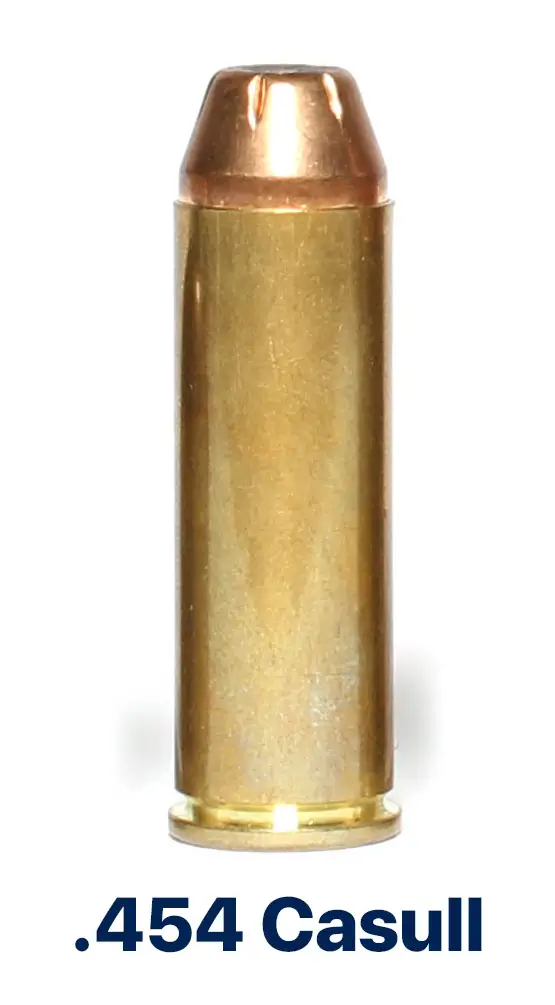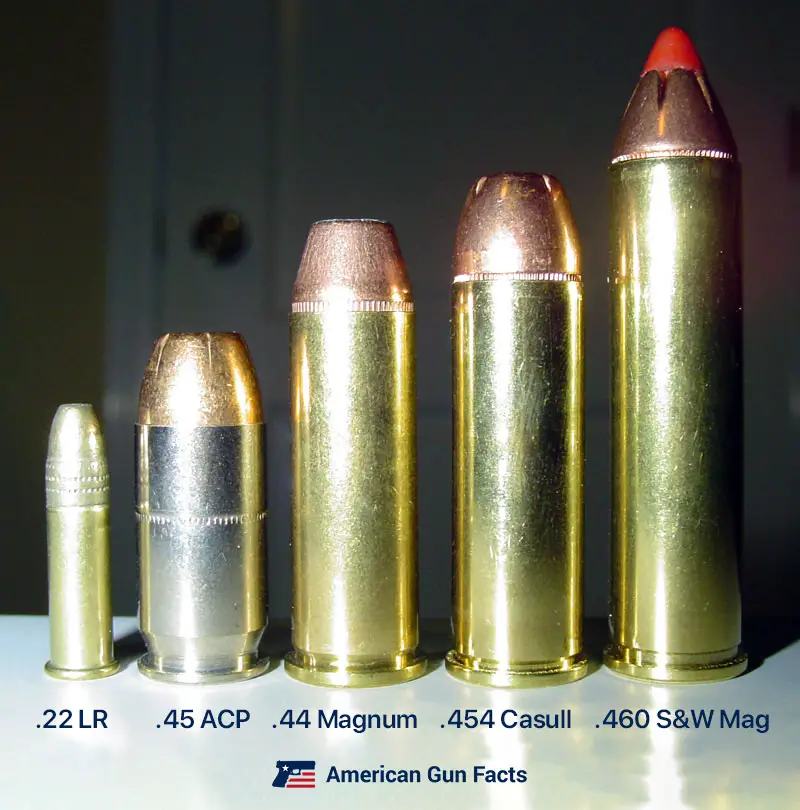Today, we’re going to give you the scoop on two of the most powerful handgun cartridges on the planet, the .454 Casull, and the .44 Magnum. To kick things off, we’ll start with a brief history of each of the cartridges so that we can understand them better in their intended uses and context.
Most of this piece will be a direct comparison of the two. That starts with a consideration of stopping power, before going into the ballistics in terms of range and velocity. From there, we’ll think about the practicalities of using each of these cartridges including the price and availability of not only the rounds themselves but the guns you’ll need to shoot them carefully.
To tease the results ever so slightly: both of these cartridges are exceptionally capable handgun rounds, and if you plan to shoot either very much we’d advise that you prepare a savings account for ammunition, as well as some ice for your wrist after shooting some of these exceptionally powerful loads. But, if sheer stopping power is your major concern, then either of these bullets can be exceptionally effective in capable hands, usually fired out of a long-barreled revolver.
History of the .44 Magnum

.44 Magnum has existed, practically, since the early .20th century. Hunters and sport shooters would often hand-load .44 special cartridges that were exceptionally hot. But, these were not typically widely sold.
In the mid-1950’s Elmer Keith proposed a commercial version of what we’d now call .44 Magnum to both Smith and Wesson as well as Remington, in the hopes that both companies would not only make the cartridges consistently available for sale, but design firearms that could safely handle the high pressures necessary to push large-grain .44 caliber projectiles ever faster. Smith and Wesson released its first .44 Magnum revolver in 1956.
Since then, .44 Magnum has found itself at home in two niches of the firearm community. First, popularized by Dirty Harry films, it has become somewhat popular for concealed carry, but with the caveat that the high recoil and heavy weight make it easier to shoot for larger shooters. Second, it’s been used successfully in hunting, where .44 Mangum has found good use not only in revolvers, but in lever-action rifles as well. It is in this second regard where .44 Magnum shines: it can be a superb hunting cartridge for even large game at moderate ranges.
History of the .454 Casull

Though it did not reach commercial success as quickly, the .454 Casull is nearly as old as the .44 Magnum, the former of which was developed in 1958 by Dick Casull. The cartridge, much like the .44 Magnum, began as a wildcat cartridge, in which people hand-loaded their own custom batches of ammunition, in this case, based in a .45 Colt case.
Over the years, there have been some attempts at commercialization, beginning in 1983 with a revolver by Freedom Arms. SAAMI put out commercial specs for the .454 Casull in 1983 as well.
Since the mid-1990s, a few manufacturers, including Ruger and Taurus, have produced revolvers in the cartridge. Interestingly, this cartridge is so large that it uses rifle primers as opposed to pistol primers. As far as intention is concern, .454 Casull has found a niche among those who live in areas where there are large, aggressive bear populations, as the caliber is appropriate for hunting game animals of medium to large size. It has also seen some use in long-range pistol shooting competitions where range and knockdown potential on steel plates are a priority. It is, in a word, a behemoth of a cartridge.
44 Mag vs. 454 Casull: Head to Head
Specs

| .44 Magnum | .454 Casull | |
| Date Designed | 1954 | 1958 |
| Case type | Rimmed, straight | Rimmed straight |
| Bullet diameter | .429 in (10.9 mm) | .452 in (11.5 mm) |
| Overall length | 1.61 in (41 mm) | 1.77 in (45 mm) |
| Case Capacity | 37.9 gr H2O (2.46 cm3) | 45.5 gr H2O (2.95 cm3) |
| Max Pressure | 36,000 psi (250 MPa) | 65,000 psi (450 MPa) |
Stopping Power
Stopping power is an exceptionally subjective term, but for our purposes here we will go for a measure of power that is at least a little more objective. One way to measure the power of a cartridge is muzzle energy, usually measured in foot-pounds, or ft-lbs. More foot pounds means more stopping power generally speaking.
Common .44 Magnum loadings range from about 740 ft-lbs to over 1,500: this means that the cartridge can be moderate in its recoil and energy, or it can be an extremely powerful cartridge.
.454 Casull ranges from around 1,700 ft-lbs of muzzle energy to nearly 2,000. In terms of raw numbers, 454 Casull outclasses most pistol calibers, .44 Magnum included.

With that said, both of these cartridges offer exceptional stopping power. If you can manage a decent hit on anything that is not protected by several inches of steel or the latest body armor, you can expect both the .44 Magnum and the .454 Casull to deliver good effect on target.
Technically speaking the .454 Casull is our winner in terms of stopping power, but we most certainly would not want to get hit by either.
Velocity
Much like stopping power, velocities of any cartridge can vary widely, so it makes sense to present these as a range as well.
.44 Magnum rounds usually leave the muzzle somewhere in the neighborhood of 1,180 to 1,500 feet per second. This is very much on the high end of pistol calibers period and competes in sheer velocity with rifle cartridges, which is why some people have good success hunting with .44 Magnum shot out of a lever-action rifle.
.454 Casull turns things up a not slightly here as well, leaving the muzzle between 1,400 feet per second to 1,900. Again, this is competing with rifle cartridges in terms of velocity.
While there is some overlap between the two, .454 Casull again takes the cake here as it moves a little bit faster. But, it is worth saying that both of these are exceptionally fast-moving pistol rounds. Both will benefit well from either long-barreled revolvers or being fired from lever action rifles. The high velocity makes for relatively flat trajectories out to extended ranges when talking in conversation with other pistol calibers.
Both .44 Magnum and .454 Casull are great performers in terms of velocity, but the latter generally moves a little bit quicker.
Range
Discussing effective range is, like stopping power, more than a little subjective. In the right hands, both of these cartridges can certainly make hits out to well over 100 yards, making them popular choices among long-distance pistol shooters. If you’re looking to make holes in paper or ring steel gongs at impressive ranges, either one of these cartridges will more than get the job done.
With that said, more muzzle energy and velocity translate to better impact on targets, and flatter trajectories. In terms of being able to ethically kill game animals at a given distance, the .454 Casull wins out.
We do wonder, though, what the added recoil of the .454 Casull over the .44 Magnum does to the accuracy equation. Most shooters have some sort of flinch when they begin training, but many work it out with practice. .454 Casull, unlike a lot of pistol calibers, does have a ton of recoil. Thus, we would expect even experienced shooters to have more than a little flinch when shooting this large caliber.
Both cartridges are exceptionally accurate: the limiting factor on range here is likely going to be shooter flinch and fatigue.
Cost and Availability
Here comes the unpleasant part. Both of these cartridges are expensive. As of July 2022, .44 Magnum ammunition is commonly around a dollar per round, and .454 Casull ammunition is often $1.50 per round or greater. Much like their velocities, these prices are the kind of thing that you usually see in rifle rounds, which makes sense given the amount of brass, powder, and lead that goes into making these cartridges.

Firearms to fire .44 Magnum with are also on the expensive side. About the best deals we could find would be used firearms, and those are still around $500 for a Smith and Wesson revolver. .454 Casull firearms are even more expensive, and the cheapest options we could find began at around $800, with used firearms in the caliber being difficult to find at best.
Neither the .44 Magnum nor the .454 Casull are going to be your budget range plinkers: these are high-end cartridges and the firearms that shoot them are made with that in mind. If you are interested in either of these cartridges long term, a return to the roots of both makes sense, and you might want to reload them instead of always buying new.
Conclusion
Both the .44 Magnum and the .454 Casull trace their origins to hunting revolvers from the 1950s. The former found greater and earlier commercial success, but, as far as we can tell, the latter is the better performer in terms of range and stopping power if you can take the recoil.
While we do not have a ton of personal experience with .454 Casull, we expect it to do increasingly well commercially, as there seems to be a renewed fascination with long-range, powerful handgun cartridges over about the last decade.

George has been an avid shooter for twenty years. He began shooting when he was gifted a Browning SA-22 for target practice. Now, as an academic, he combines his love of firearms and knowledge of history to write for firearms blogs and is still a frequent sight at the local range.

And you wouldn’t include the S&W 500????